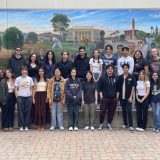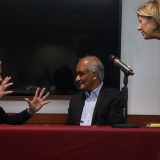
Three Minutes: A Lengthening A Glimpse into the lives of unsuspecting Jewish citizens in 1938
September 24, 2022
In 2009, Wilkinson College Presidential Fellow in English and History, Dr. Glenn Kurtz came across some old film in his parent’s closet. He discovered the film documented his grandparents’ trip to Europe in 1938, which included three minutes of David and Liza Kurtz’s visit to Nasielsk, Poland. These three minutes would become the only known footage that captured this predominantly Jewish town before the German army invaded Poland on September 1, 1939.
“…the moment I saw these images, I knew that they were something of profound historical worth. Seeing all these people and knowing that it was 1938, I realized these were probably the only moving images of this community and very likely the only images at all of the many people we see, particularly children. So, I just felt this tremendous sense of responsibility to their memory. I had inherited evidence of their lives, maybe the only evidence.”
Intrigued by his grandfather’s footage, Kurtz wrote Three Minutes in Poland: Discovering a Lost World in a 1938 Family Film, which caught the eye of filmmaker Bianca Stigter, who created the film, Three Minutes: A Lengthening.
Recently Wilkinson College’s Rodgers Center for Holocaust Education and Dodge College of Film and Media Arts co-hosted a screening of the historical film followed by a Q&A with Stigter and Kurtz, moderated by Dodge Dean Steve Galloway as part of the Rodgers Center Lecture Series.
“It immediately made a very big impression on me to see this vibrant community of these children looking into the camera as if they really wanted to be seen,” said Stigter. “For me it was very special that it was in color, which is very rare to see something in color of that area in time.”
Inspired, Stigter found a way to prolong the experience to “…somehow meet these people for a little bit longer,”resulting in a documentary that is unlike any other.
Stigter focused solely on the family film footage. In Three Minutes: A Lengthening, there aren’t any visible talking heads, reenactments, or additional elements that would distract viewers or dilute the three minutes of original footage. Instead, Stigter’s documentary features an extended 70 minutes that shows viewers the three minutes of family film repeatedly by extending the footage in various ways: slow motion, stilled, forwarded or backwards, paused, and edited with voice-over narration (provided by Actor Helena Bonham Carter) and interviews with survivors.
“I thought the film was amazing, and unlike any piece of Holocaust history I’ve seen before,” said senior Kellan Jenner (History and Public Relations & Advertising double major). “It presented a microhistory of one town in Poland, and I was able to learn about specific people and what they went through. It was devastating to see such happy faces on film and know what would happen to them just one year later. It made me really connect with the history and learn in a personal way that isn’t often provided in Holocaust history, since it is such an important piece of world history,” she said.
Stigter expressed that the biggest challenge she faced was only using the three-minute footage in the documentary and explained how the making of this documentary was trial and error. She worried the approach to the documentary would not work or be too boring. However, she was determined to stay as close to the footage material as possible and to remain respectful while doing so.
When reflecting on how this project has changed his views on life and the Holocaust, Kurtz replied with his favorite scene of the family film.
“There is that moment in the end where we talk about a frame of the film, where the birds appear. To me [that moment] is such a poignant moment, because it emphasizes the profoundly fleetingness and the chance of appearance or disappearance of those birds,” he said. “They just happened to be there for this tiny fraction of a second. And this film itself just happened to be there for three minutes. This tiny, tiny fragment ends up having this tremendous richness.”
The original footage can be viewed at the United States Holocaust Memorial Museum, titled, Jewish quarter in Poland.



